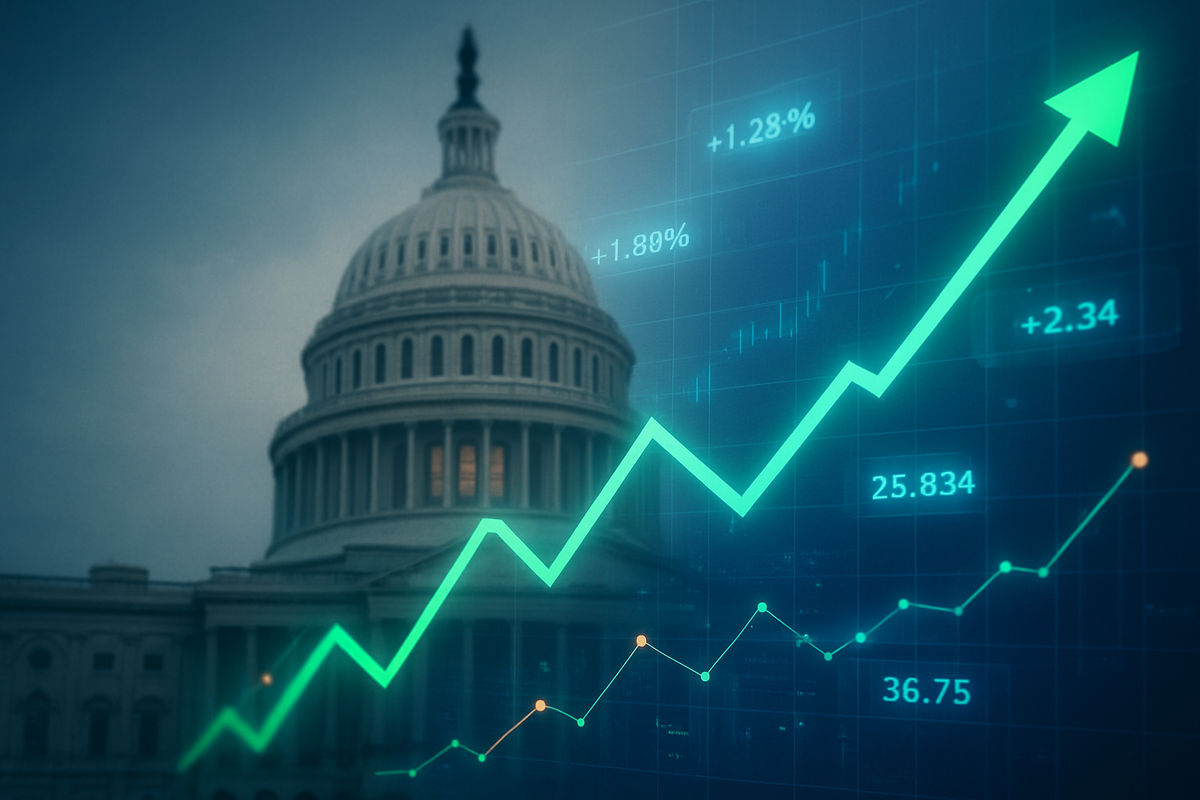
Global financial markets are breathing a collective sigh of relief, with stock futures surging as investors cling to cautious optimism for an imminent end to the protracted United States government shutdown. Despite the federal government entering a record-breaking second month of closure, a glimmer of hope from recent bipartisan talks in the Senate has ignited a widespread positive sentiment, reflecting a broader market resilience and a tendency to "look through the noise" of political impasses.
This renewed optimism on November 9, 2025, sees major indices like Nasdaq futures (NASDAQ: COMP) and S&P 500 futures (NYSEARCA: SPY) registering significant gains, alongside a robust performance in Asian-Pacific and European markets. The prevailing sentiment suggests that while the economic costs of the shutdown are mounting, market participants are more focused on the potential for a breakthrough, signaling a strong belief that a resolution, even if temporary, is on the horizon.
Shutdown Drags On, But Resolution Hopes Emerge from Senate Chambers
The current US government shutdown, which commenced on October 1, 2025, has now etched its name into history as the longest in the nation's history, extending for over 40 days. The genesis of this prolonged fiscal stalemate lies in a deep-seated disagreement between the Republican-led House and the Democratic-controlled Senate over the appropriations legislation for the 2026 fiscal year. A primary sticking point has been the Democratic insistence on extending Affordable Care Act (ACA) subsidies, which are slated to expire at the close of 2025, a provision largely opposed in the Republican appropriations bill.
Repeated attempts to pass stopgap continuing resolutions (CRs) have failed to bridge the partisan divide, with both chambers consistently rejecting each other's proposals. The shutdown has left approximately 900,000 federal employees furloughed, while another two million continue to work without pay, disrupting numerous government operations from national parks to various agency functions. Economically, the cost has been steep, with estimates suggesting a weekly GDP loss of around $15 billion and a discernible slump in consumer sentiment.
However, a significant development on Sunday, November 9, 2025, injected a much-needed dose of optimism. The Senate successfully advanced a compromise bill, albeit narrowly, aimed at reauthorizing government funding and addressing the plight of federal workers. This bipartisan effort reportedly omits the contentious healthcare subsidies, a concession that saw many Democratic senators and House Democrats initially reject the measure. Nevertheless, the bill secured the crucial 60 votes required to proceed in the Senate, primarily with Republican backing and support from a handful of moderate Democrats. Further reports indicate that former President Donald Trump has also signaled a positive outlook, hinting at a potential agreement that could involve a stopgap funding measure through January 2026, alongside three full-year bills. While Senate Democrats have reportedly lent their support to this broader proposal, its approval by the House and the President's signature remain critical next steps.
Companies Navigate the Fiscal Chasm: Winners and Losers Emerge
The protracted US government shutdown creates a bifurcated landscape for public companies, with some facing immediate financial headwinds and others proving more resilient or even finding opportunistic avenues.
Companies heavily reliant on federal contracts are among the most negatively impacted. Large defense contractors like Lockheed Martin (NYSE: LMT), Northrop Grumman (NYSE: NOC), and RTX (NYSE: RTX), while often having multi-year contracts, still face significant operational and financial risks due to delayed payments and halted new program starts. Smaller and newer defense technology firms, along with broader government contractors providing IT services or consulting, are particularly vulnerable to missed or late payments and the inability to communicate with furloughed federal contracting officers. Firms such as Leidos (NYSE: LDOS), Leonardo DRS (NASDAQ: DRS), and General Dynamics (NYSE: GD) have noted resilience in Q3 results, often due to mission-critical contracts, but the broader outlook for the sector remains cautious until funding clarity returns.
The tourism and travel industry is another significant casualty. The closure of national parks and museums, coupled with reduced government travel and diminished consumer confidence, directly impacts airlines like United Airlines (NASDAQ: UAL) and American Airlines (NASDAQ: AAL), which have been forced to reduce flights due to air traffic control staffing shortages. The US hotel industry has reportedly lost hundreds of millions, with bookings and travel plans facing widespread cancellations. Companies sensitive to regulatory delays, particularly in the pharmaceutical and biotechnology sectors, also suffer. The FDA's reduced staffing halts reviews of new drug and medical device applications, delaying potential market approvals for companies like Exelixis (NASDAQ: EXEL). Similarly, the SEC's furloughing of staff delays IPO reviews and other capital market transactions. Consumer discretionary companies, including major retailers like Walmart (NYSE: WMT) and Target (NYSE: TGT), and food service giants like Starbucks (NASDAQ: SBUX), also feel the pinch from reduced consumer spending, especially among federal employees working without pay.
Conversely, certain sectors demonstrate greater resilience or even present opportunities. Defensive sectors, such as utilities and consumer staples, tend to outperform during periods of political uncertainty, reflecting a flight to stability due to their essential nature and predictable cash flows. The Utilities Select Sector SPDR (NYSEARCA: XLU) has shown gains during the initial days of the current shutdown. Safe-haven assets like Gold and Bitcoin have also seen rallies, with Bitcoin reportedly surging above $116,000 and gold hitting $3,850 per ounce during the 2025 shutdown, indicating a broader range of defensive options for investors. Companies with diversified revenue streams, not solely reliant on the US government, are better positioned to weather payment delays. Furthermore, some analysts suggest that an oversold defense sector during a shutdown could present a strategic buying opportunity for long-term investors, anticipating a rebound once funding is restored.
Broader Implications: A Shadow Over Economic Stability and Governance
The current US government shutdown, now the longest in history, casts a long shadow beyond immediate market reactions, exacerbating existing economic vulnerabilities and highlighting systemic challenges in governance. It underscores a troubling trend of increasing political polarization, where fiscal policy battles repeatedly lead to disruptive impasses.
One of the most profound broader implications is the intensified economic uncertainty. The shutdown directly impacts consumer and business confidence, leading to delayed investment decisions and reduced discretionary spending. Small businesses, in particular, face a dual crisis: the Small Business Administration's inability to disburse federally guaranteed loans deprives thousands of critical capital, while many also lose revenue from halted federal contracts. The travel and tourism sector continues to be disproportionately affected, with flight cancellations and delays due to staffing shortages at the TSA and FAA, and the closure of national parks, resulting in billions in lost travel spending. Crucially, the shutdown creates a "data blackout," as federal statistical agencies suspend the release of vital economic data like employment reports and the Consumer Price Index. This leaves policymakers, including the Federal Reserve, and investors "flying blind," complicating informed decision-making.
Historically, government shutdowns have shown a consistent pattern of economic cost. Short shutdowns have minimal impact, but prolonged ones measurably reduce Gross Domestic Product (GDP) growth, typically by 0.1 to 0.2 percentage points per week. For instance, the five-week partial shutdown in 2018-2019 reduced GDP growth by 0.1% in Q4 2018 and 0.2% in Q1 2019, with some permanent loss of economic output. The current shutdown is estimated to be costing the US economy around $15 billion per week. While the overall stock market, particularly the S&P 500, has historically shown resilience and often recovers quickly after a resolution, short-term volatility is a given. The recurring nature of these shutdowns, however, points to an erosion of public confidence in the government's ability to effectively manage its affairs.
Regulatory and policy implications are also significant. A prolonged shutdown creates a growing backlog of regulatory work, delaying new rulemakings and the finalization of existing ones. Routine inspections (e.g., food safety by the FDA) and enforcement actions are largely suspended, posing risks to public health and safety. Businesses requiring federal licenses, permits, or approvals face significant delays, impacting various sectors from alcohol producers to companies seeking SEC registrations or antitrust reviews. This directly hinders business launches, investment, and dealmaking. Furthermore, the stress of furloughs and working without pay can lead to a loss of institutional knowledge and expertise within federal agencies as employees seek more stable employment, impacting government effectiveness for months or even years after a resolution.
Navigating the Path Ahead: Scenarios and Strategic Responses
As the US government shutdown nears a potential resolution, the path forward presents both short-term relief and long-term uncertainties for markets and businesses. The immediate focus is on the nature and duration of the impending agreement, while the long-term outlook will be shaped by whether this crisis leads to fundamental changes in fiscal governance.
In the short term, the most likely scenario points to an imminent, albeit temporary, resolution. The recent breakthrough in the Senate, which saw a House-passed short-term funding measure advance with bipartisan support, suggests a deal is close. This agreement is anticipated to include an interim funding solution, possibly extending government operations through January 2026, and crucially, guarantee a future vote on the contentious ACA tax credits. This aligns with historical precedents where most shutdowns are resolved by passing a Continuing Resolution (CR). While this provides immediate relief, it also highlights a pattern of governing by crisis, potentially leading to further fiscal cliffs down the line.
Looking further ahead, several long-term scenarios could unfold. The government might continue to rely on short-term CRs, perpetuating uncertainty. Alternatively, the pressure from a prolonged shutdown could force a more comprehensive budget agreement, requiring substantial bipartisan compromise on core spending priorities. There is also a push for budget process reforms, such as automatic continuing appropriations, to prevent future shutdowns, though deep political divisions make their adoption challenging. Shifts in political power in future election cycles could also alter the approach to budget negotiations, but the underlying structural issues may persist.
For investors, the post-shutdown environment presents both opportunities and challenges. Market opportunities may arise in defensive assets, such as high-quality corporate bonds and international diversification, as investors seek to mitigate US political risk. Sectors that were temporarily suppressed, like government contractors or tourism, could see a "catch-up" bounce once funding is restored. Private sector data and analytics providers may also see increased demand due to the unreliability of federal data during such events. However, significant challenges remain. The direct reduction in economic output will linger, and regulatory backlogs will continue to impede businesses reliant on federal approvals. Reduced consumer spending and lingering uncertainty could dampen overall economic activity, while the "data blackout" complicates the Federal Reserve's ability to make informed monetary policy decisions.
A Cautious Optimism: Assessing the Lasting Impact and Future Watchpoints
The current US government shutdown, while a significant disruption, underscores a recurring theme in financial markets: their remarkable ability to "look through" political noise and focus on fundamental economic drivers. While the immediate costs are tangible and severe for affected federal employees and businesses, the broader market's reaction, characterized by cautious optimism for a resolution, suggests that investors largely view these events as temporary political skirmishes rather than existential threats to the economy.
Key takeaways from this prolonged shutdown include the direct economic contraction through lost GDP and disrupted public services, the significant financial strain on federal workers and contractors, and the critical information vacuum created by delayed economic data. These factors highlight the inherent fragility introduced by political gridlock into the nation's economic fabric. Yet, historical data consistently shows that while short-term volatility is common, the overall stock market tends to be resilient, often recovering and even advancing in the months following a shutdown's resolution. Safe-haven assets like US Treasuries have typically provided stability during these periods.
Moving forward, the market's trajectory will largely depend on the specifics of the shutdown's resolution. A temporary CR might offer immediate relief but could set the stage for future fiscal battles, whereas a more comprehensive agreement could instill greater long-term confidence. The lasting impact of this shutdown will likely include some permanent economic damage from unrecoverable GDP and deferred investments, along with a continued erosion of public confidence in governmental efficacy. However, the market's current positive reaction reflects a belief that a resolution, even if imperfect, is preferable to continued impasse.
Investors in the coming months should closely monitor the details of the shutdown's resolution, looking for any underlying agreements on future spending or debt ceiling issues. The resumption of regular economic data releases will be crucial for a clearer assessment of the economy's health and the Federal Reserve's monetary policy stance. Observing consumer spending trends, particularly as the holiday season approaches, and corporate earnings reports from sectors most affected by the shutdown, will provide vital insights into the pace of economic recovery. Finally, while political volatility may persist, long-term investors should consider any market pullbacks driven solely by shutdown anxieties as potential opportunities to invest in fundamentally strong assets.
This content is intended for informational purposes only and is not financial advice






